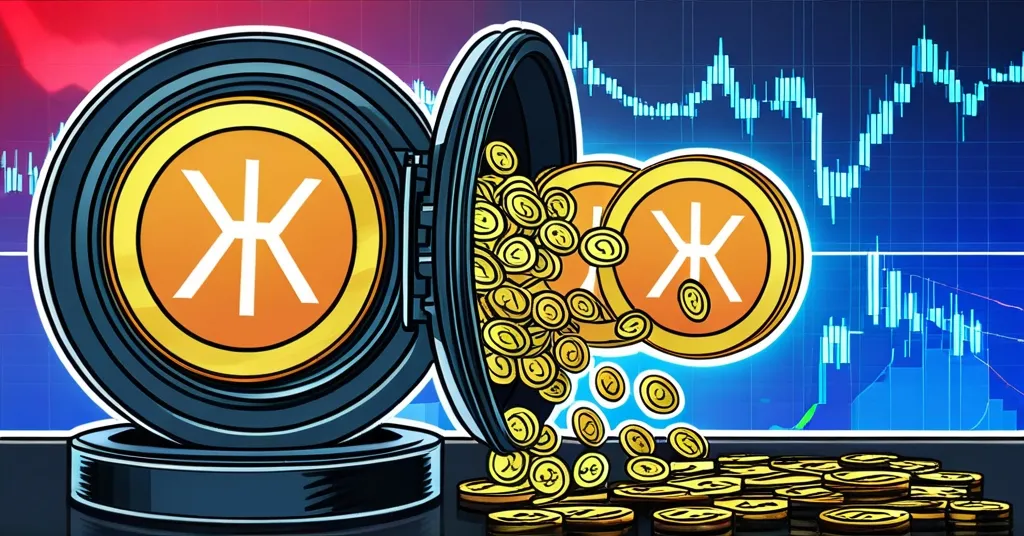Ripple Transfers $690M in XRP, Launches RLUSD Stablecoin

Ripple Transfers $690M in XRP, Launches RLUSD Amid Market Fluctuations
Ripple Labs made a significant move on January 9, transferring 300 million XRP, valued at around $690 million, to an intermediary address as part of their ongoing ‘XRP Unlock Strategy.’ Amidst recent market volatility, XRP has been trading around $2.28-$2.30, following a 360% surge in 2024. Concurrently, Ripple has launched RLUSD, a US dollar-pegged stablecoin, aiming to compete with market giants like USDT and USDC.
- Ripple transfers 300M XRP worth $690M
- Part of ongoing XRP Unlock Strategy
- XRP price fluctuates, currently at $2.28-$2.30
- Ripple launches RLUSD stablecoin
- RLUSD aims to compete with USDT, USDC
XRP Unlock Strategy Explained
Ripple’s ‘XRP Unlock Strategy’ is akin to releasing a controlled amount of XRP from a vault to manage how many tokens are circulating in the market. This practice aims to maintain liquidity and control the supply of XRP. By moving tokens to intermediary addresses, Ripple can distribute them strategically, potentially impacting the market price. Critics have expressed concerns that such large unlocks could destabilize XRP’s value, with some fearing price manipulation. On the other hand, supporters argue that this strategy helps maintain a healthy ecosystem for XRP, ensuring there’s enough in circulation to meet demand.
The crypto market is no stranger to volatility, and XRP’s recent fluctuations reflect this reality. After a remarkable 360% surge from $0.50 at the start of 2024, XRP has experienced a 4.52% decrease over the past week but a slight 1.5% increase in the last day. This rollercoaster ride keeps investors on their toes, showcasing the unpredictable nature of cryptocurrencies.
RLUSD: Ripple’s Stablecoin Ambition
A stablecoin, like RLUSD, is a type of cryptocurrency designed to have a stable value, often pegged to a fiat currency like the US dollar. Ripple’s new stablecoin, RLUSD, was launched with an ambitious goal to be listed on more major exchanges by the end of 2025. Bitstamp has already confirmed support for RLUSD, signaling market interest. However, entering the stablecoin arena to compete with established players like USDT and USDC is no easy task.
Jack McDonald, Ripple’s senior vice president of stablecoins, has highlighted the technical and regulatory challenges of listing RLUSD. “Listing a stablecoin involves technical setup and navigating different rules and regulations, especially since it needs to work on different blockchain systems like Ethereum and the XRP Ledger,” McDonald explained. He also emphasized the importance of strategic partnerships in getting RLUSD listed on major platforms, hinting at potential future collaborations with giants like Coinbase and Binance.
Ripple’s move into stablecoins is a bold play, but it’s not without its hurdles. The stablecoin market is crowded, and regulatory bodies are keeping a close watch. Navigating the regulatory landscape will be crucial for RLUSD’s success, as will building liquidity to compete effectively with the likes of USDT and USDC.
Market Reactions and Future Prospects
The recent XRP unlock has led to mixed reactions in the market. While some see it as a necessary part of Ripple’s strategy to manage token supply, others are wary of the potential price impact. The crypto market’s volatility means that today’s surge could be tomorrow’s slump, but if Ripple can successfully navigate these waters, RLUSD might just shake up the stablecoin market.
From a Bitcoin maximalist perspective, the need for another stablecoin might be questioned, especially when Bitcoin is seen as the ultimate financial solution. However, the reality is that stablecoins like RLUSD serve a different purpose, offering stability and utility in a way that Bitcoin does not.
Counterpoints and Controversial Angles
While RLUSD’s potential is exciting, it’s important to consider the counterpoints. Regulatory hurdles could pose significant challenges, especially in regions like the EU with strict regulations like MiCA. Moreover, the stablecoin market is already saturated, and RLUSD will need to carve out its niche to succeed.
There are also ethical considerations to Ripple’s XRP strategy. Some argue that the concentration of XRP in a few hands could undermine the principles of decentralization that many in the crypto community hold dear. It’s a high-stakes game, and Ripple’s moves will continue to be scrutinized.
Key Takeaways and Questions
- What is Ripple’s ‘XRP Unlock Strategy’?
Ripple’s ‘XRP Unlock Strategy’ involves the regular release of XRP tokens from its reserves to intermediary addresses for further distribution, aiming to manage its token supply and impact the market.
- How has the XRP market price reacted to the recent token unlock?
The XRP market price has shown mixed reactions, with a 4.52% decrease over the past week but a 1.5% increase in the last day, indicating volatility.
- What is RLUSD, and what are Ripple’s plans for it?
RLUSD is Ripple’s newly launched US dollar-pegged stablecoin. Ripple plans to list RLUSD on more major exchanges by the end of 2025, focusing on building liquidity and navigating regulatory challenges to compete with established stablecoins.
- How does RLUSD aim to compete with other stablecoins like USDT and USDC?
RLUSD aims to compete by building liquidity and securing regulatory approval, potentially capitalizing on regulatory challenges faced by competitors like Tether in regions like the EU.
- What role do strategic partnerships play in RLUSD’s expansion?
Strategic partnerships are crucial for RLUSD’s expansion, as they facilitate listings on major platforms like Coinbase and Binance, which have exclusive relationships with other stablecoins.
- What could be the broader impact of Ripple’s moves on the cryptocurrency market?
Ripple’s actions could influence market dynamics by introducing new liquidity through RLUSD and managing XRP’s supply. However, they might also increase volatility and scrutiny over large token unlocks, affecting investor confidence and market stability.



